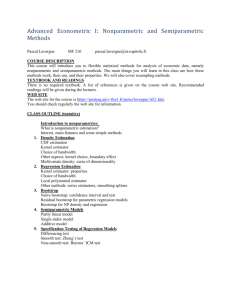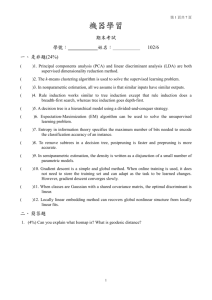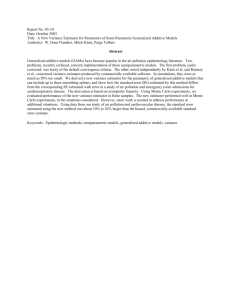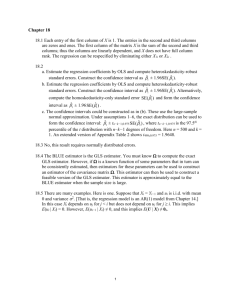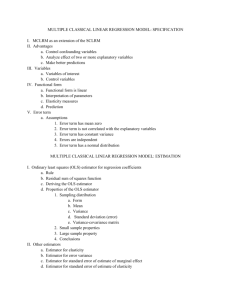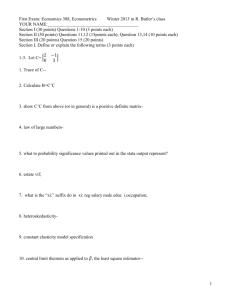Robinson`s square root of N consistent semiparametric regression
advertisement
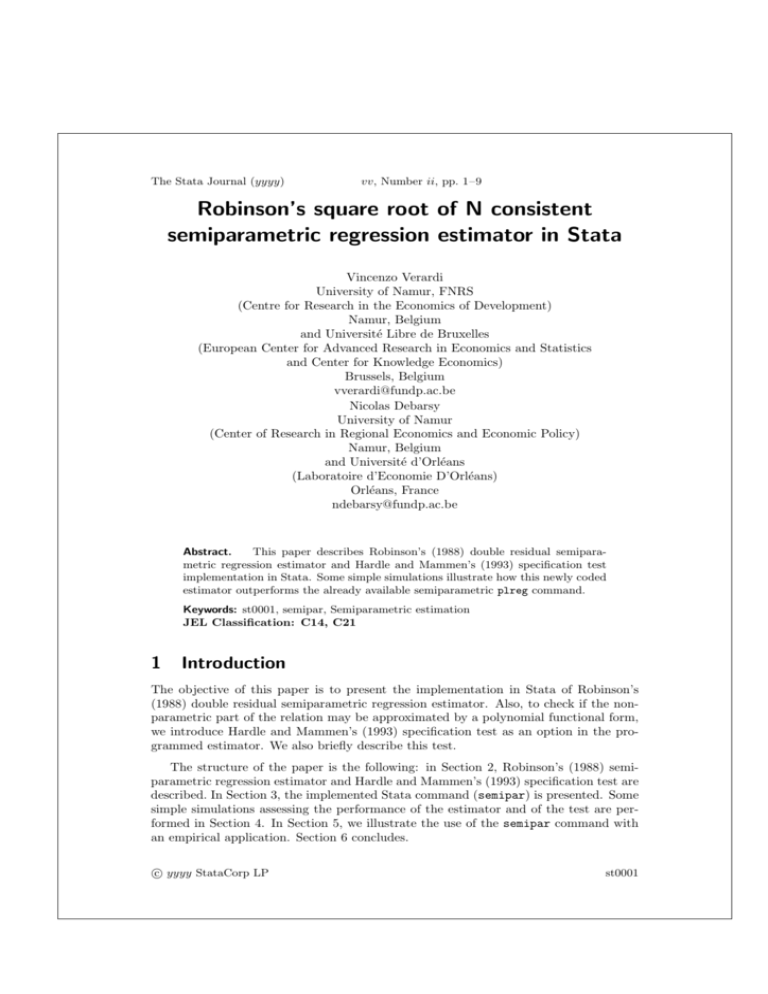
The Stata Journal (yyyy) vv, Number ii, pp. 1–9 Robinson’s square root of N consistent semiparametric regression estimator in Stata Vincenzo Verardi University of Namur, FNRS (Centre for Research in the Economics of Development) Namur, Belgium and Université Libre de Bruxelles (European Center for Advanced Research in Economics and Statistics and Center for Knowledge Economics) Brussels, Belgium vverardi@fundp.ac.be Nicolas Debarsy University of Namur (Center of Research in Regional Economics and Economic Policy) Namur, Belgium and Université d’Orléans (Laboratoire d’Economie D’Orléans) Orléans, France ndebarsy@fundp.ac.be Abstract. This paper describes Robinson’s (1988) double residual semiparametric regression estimator and Hardle and Mammen’s (1993) specification test implementation in Stata. Some simple simulations illustrate how this newly coded estimator outperforms the already available semiparametric plreg command. Keywords: st0001, semipar, Semiparametric estimation JEL Classification: C14, C21 1 Introduction The objective of this paper is to present the implementation in Stata of Robinson’s (1988) double residual semiparametric regression estimator. Also, to check if the nonparametric part of the relation may be approximated by a polynomial functional form, we introduce Hardle and Mammen’s (1993) specification test as an option in the programmed estimator. We also briefly describe this test. The structure of the paper is the following: in Section 2, Robinson’s (1988) semiparametric regression estimator and Hardle and Mammen’s (1993) specification test are described. In Section 3, the implemented Stata command (semipar) is presented. Some simple simulations assessing the performance of the estimator and of the test are performed in Section 4. In Section 5, we illustrate the use of the semipar command with an empirical application. Section 6 concludes. c yyyy StataCorp LP st0001 2 Robinson’s semiparametric regression in Stata 2 Estimation method 2.1 Robinson’s (1988) semiparametric regression estimator Consider a general model of the type yi = θ0 + xi θ + f (zi ) + εi , i = 1, ..., N (1) where yi is the value taken by the dependent variable for individual i, xi is the row vector of characteristics of individual i, θ0 is a constant term and εi is the disturbance assumed to have zero mean and constant variance σε2 . Variable z is an explanatory variable that enters the equation nonlinearly according to a non-binding function f . This model can be estimated using Robinson’s (1988) double residual methodology that starts by applying a conditional expectation to both sides of (1). This leads to E (yi |zi ) = θ0 + E (xi |zi ) θ + f (zi ) i = 1, ..., N (2) By subtracting (2) from (1), we have yi − E (yi |zi ) = (xi − E (xi |zi )) θ + εi i = 1, ..., N (3) If the conditional expectations are known, parameter vector θ can easily be estimated by fitting (3) by ordinary least squares. If they are unknown, they have to be estimated by calling on some consistent estimators yi = my (zi ) + ε1i and xki = mxk (zi ) + ε2ki , where k = 1, ..., K is the index of the explanatory variables entering the model parametrically. Robinson’s (1988) double residual estimator is hence the OLS estimation of model yi − m̂y (zi ) = (xi − m̂x (zi )) θ + εi i = 1, ..., N (4) where xi − m̂x (zi ) is the row-vector of the differences between each explanatory variable xki and the fitted conditional expectation of xki given zi . The estimated coefficients vector is therefore !−1 X X ′ ′ θ̂ = (xi − m̂x (zi )) (xi − m̂x (zi )) (xi − m̂x (zi )) (yi − m̂y (zi )) i (5) i with variance (if errors are i.i.d) V ar θ̂ = σε2 X i ′ (xi − m̂x (zi )) (xi − m̂x (zi )) !−1 (6) 3 V. Verardi, N. Debarsy where σε2 is the variance of the error term. If errors are non i.i.d., standard sandwich and cluster variance formulas can be used. Having estimated parameter vector θ, it is now possible to fit the nonlinear relation between zi and yi by simply estimating equation (7) presented below nonparametrically. yi − xi θ̂ = θ0 + f (zi ) + εi , 2.2 i = 1, ..., N (7) Hardle and Mammen’s (1993) test It is sometimes suggested that nonparametric functions may be approximated by some parametric polynomial alternative. To test for the appropriateness of such an approximation, Hardle and Mammen (1993) develop a statistic which compares the nonparametric and parametric regression fits using squared deviations between them. The test-statistic is: N 2 √ X Tn = N h (8) fˆ(zi ) − fˆ(zi , θ) π(·) i=1 where fˆ(zi ) is the nonparametric function estimated in (7), fˆ(zi , θ) is an estimated parametric function, h is the bandwidth used and π(·) is a weighting function for the squared deviations between fits. To obtain critical values for the test, Hardle and Mammen (1993) suggest to call on simulated values obtained by wild bootstrap. Obviously, an absence of rejection of the null (i.e. “accepting” the parametric model) means that the polynomial adjustment is at least of the degree that has been tested. We implemented this estimator and the specification test in Stata under the command semipar which is described below. 3 The semipar command The semipar command fits Robinson’s double residual estimator in the case of a unique variable entering the model nonparametrically. The default kernel regression used for all stages is a gaussian kernel weighted local polynomial fit.1 The optimal bandwidth used minimizes the conditional weighted mean integrated squared error. The general syntax for the command is: semipar varlist if in weight , nonpar(varname) generate(string) partial(string) kernel(string) degree(#) trim(#) nograph ci level(#) title(string) ytitle(string) xtitle(string) robust cluster(varname) test(#) nsim(#) weight test(varname) The first option, nonpar, is compulsory and necessary to declare which variable 1. The kernel is of order 2. 4 Robinson’s semiparametric regression in Stata enters the model nonparametrically. All other choices are optional. The first one, generate, reproduces the “nonparametrically” fitted dependent variable. The user chooses the name of this new variable by defining it in parentheses. Similarly, the partial option is needed to generate a new variable that contains the parametric residuals (i.e. the left-hand side of equation (7)). The kernel allows to change the kernel function. The degree option allows the user to specify the degree of the local polynomial fit used to nonparametrically estimate the regressions. By default, it is set to 1. The trim option allows to trim the data relying on a value of the probability distribution function of the nonpar variable. The default value is set to 0 (no trimming). The option nograph should be used if the user does not want the graph of the nonparametric fit of the variable set in nonpar to appear. The ci option allows to visualize the confidence interval around the nonparametric fit2 , while the level option sets the level of confidence for inference (by default set to 95%). The options title, ytitle and xtitle are used to indicate respectively the title and the labels of the axes of the graph illustrating the nonparametric relation between the dependent variable and the variable defined in the nonpar option. The robust and cluster options call for standard errors of the estimated parameters that are respectively resistant to heteroskedasticity and clustered errors. The test option implements Hardle and Mammen’s (1993) statistic to test whether the nonparametric fit could be approximated by a polynomial fit, the order of which must be set by the user. For the sake of clarity, we rescaled the statistic in such a way that it can be compared with the quantile of a Normal distribution. Note however that the test is not normally distributed. The nsim option defines the number of bootstrap replicates used to get inference. Its default value is set to 100. Finally, the weight test option allows to give different weights to the squared deviation between the nonparametric fit and the polynomial adjustment in the computation of the test (i.e. introducing π(·) in equation (8)). By default, this weighting vector is set to ιN /N with ιN a unit vector of dimension N . To assess the performance of the programmed estimator, in the next section we present some simple simulations in which we compare this estimator with the already available plreg command. The latter implements Yatchew’s (1998) difference estimator where the nonparametric part in (1) is partialled out by differencing rather than by removing the conditional expectations. Since the highest efficiency of Yatchew’s (1998) estimator is attained by a differencing of order 10, we will use this differencing order as a benchmark. 4 Simulations The simulation setup is the following. To begin, we generate (for a sample of 300 observations) two explanatory variables x2 and x3 from two independent N (0, 1). An additional random variable x1 is generated from a discrete Uniform distribution on [−10, 10]. This sample design remains unchanged for all simulations. Then, for each replication, we generate an error term e from a standard normal and create variable y according to DGP y = x1 + x21 + x2 + x3 + e. We run the semipar and plreg estimators for each replication and Table 1 reports both the bias and MSE of the coefficients associated 2. Further information about confidence intervals can be found in the help of lpoly. 5 V. Verardi, N. Debarsy Table 1: Comparison between Bias x2 Bias x3 plreg -0.4695 -0.1039 semipar -0.0435 -0.0183 semipar and plreg MSE x2 MSE x3 0.2208 0.0112 0.0022 0.0007 with x2 and x3 . We carry out 1000 simulations. The variable that enters the equation nonparametrically is generated from a discrete Uniform distribution on purpose to illustrate the fragility of plreg with respect to this kind of data. Robinson’s (1988) estimator, that is based on partialling out the nonparametric part removing conditional expectations rather than by differencing, behaves much better. In this setup, Robinson’s (1988) estimator leads to smaller biases than Yatchew’s (1998) differencing estimator. From equation (7), this also implies that the nonparametric fit is better estimated by semipar than by plreg. To illustrate the fitting performance of the proposed estimation procedure, we generate four samples according to the following DGPs: a) y = x2 + x3 + e b) y = x1 + x2 + x3 + e c) y = x1 + x21 + x2 + x3 + e d) y = x1 − x21 − x31 + x2 + x3 + e. In Figure 1, we present the scatter plots, the non-parametric fit (thick plain line) and the true DGP (red dashed line) related to the four DGPs described above. As expected, the results are unambiguous. In the absence of any relation between x1 and y (panel a), no clear pattern emerges and the non-parametric curve lies close to the horizontal line (the true DGP). In the three other cases (panels b, c and d), the nonparametric estimation of the relation matches the true functional form quite well. As mentioned in the previous section, the Tn statistic assesses the adequacy of a polynomial adjustment compared to a nonparametric fit. Table 2 presents the performance of the test for the DGPs described above. The rows indicate the order of the generated polynomial while the columns specify the order of the polynomial that has been tested. Thus, the diagonal (and the upper triangle) elements are the simulated sizes of the test while elements below the main diagonal are some measure of power. To construct this table we replicated the DGPs 1000 times. Each time a new error term is randomly drawn and a new dependent variable is generated (the design space remains unchanged). Inference for the test is based on 100 bootstrap replications. We observe that the test has good rejection rates when the order of the polynomial adjustment tested is lower than the generated one. Besides, the size of the test (whose theoretical value is set at 5%), is very close to its nominal value. 6 Robinson’s semiparametric regression in Stata Figure 1: Non-parametric fit of the four DGPs Table 2: Performance of the comparison Test Tn Order tested 0 1 2 3 0 0.053 0.06 0.055 0.039 True 1 1 0.064 0.055 0.021 Order 2 1 1 0.06 0.062 3 1 1 1 0.066 Figures correspond to rejection rates of the test. 7 V. Verardi, N. Debarsy 5 Example To illustrate the usefulness of this semiparametric model in empirical applications, we call on a dataset used by Wooldridge (2002) that studies the effects of an incinerator location on housing prices. The data are for houses that were sold during the year 1981 in North Andover, MA; 1981 was the year construction began on a local garbage incinerator. The dependent variable is the log of price of houses (lprice) and the variable of interest is the distance from the house to the incinerator measured in feet and expressed in logs (ldist). To control for confounding effects, the author suggests to include the log of interstate distance (linst), the log of the square footage of the house (larea), the log of the lot size in square feet (lland), the number of rooms (rooms), the number of bathrooms (baths), and the age of the house (age) as additional covariate. However, he also asserts that the effect of the log of the interstate distance is not linear and proposes to consider it squared. In this application we carry out this exercise again but do not impose any functional form to the log of interstate distance and estimate the model semiparametrically. We then check if the square approximation is appropriate. More precisely, we run the following command lines: . use http://fmwww.bc.edu/ec-p/data/wooldridge/HPRICE3 . semipar lprice ldist larea lland rooms baths age, nonpar(linst) xtitle(linst) ci Number of obs R-squared Adj R-squared Root MSE lprice Coef. ldist larea lland rooms baths age .1083941 .4887243 .0866459 .0436451 .0806555 -.003481 Std. Err. .0640184 .0668208 .036037 .0221781 .0335251 .0005436 t 1.69 7.31 2.40 1.97 2.41 -6.40 P>|t| 0.091 0.000 0.017 0.050 0.017 0.000 = = = = 321 0.4437 0.4331 0.2646 [95% Conf. Interval] -.0175636 .3572527 .0157423 9.12e-06 .014694 -.0045506 .2343519 .6201959 .1575495 .087281 .146617 -.0024114 The results of the parametric part (see Stata output above) show that the distance from the incinerator does not seem to be significant (the t-stat associated with the coefficient is smaller than the critical value of 1.96). As far as the effect of the log of the interstate distance is concerned, Figure (2) shows that it is clearly nonlinear. Indeed, when the interstate distance increases, the effect of house prices first increases and then decreases. When we check if the quadratic approximation proposed by Wooldridge (2002) is appropriate, it turns out that this assumption is clearly rejected by Hardle and Mammen’s (1993) test (see below). However, when we compare it with a polynomial adjustment of degree 3, the null is no longer rejected which means that instead of a semiparametric model, a pure parametric model with a polynomial fit of degree 3 of linst could be used. 8 Robinson’s semiparametric regression in Stata Figure 2: Nonlinear link between the price and interstate distance (in logs) The two Stata outputs below summarize results of the Hardle and Mammen (1993) test when the polynomial adjustment tested is of order 2 or 3 respectively. These outputs do not present the results concerning the parametric part since they are the same as in the output presented above. . use http://fmwww.bc.edu/ec-p/data/wooldridge/HPRICE3 . semipar lprice ldist larea lland rooms baths age, nonpar(linst) nograph test(2) Simulation the distribution of the test statistic bootstrap replicates (100) 1 2 3 4 5 .................................................. .................................................. 50 100 H0: Parametric and non-parametric fits are not different ------------------------------------------------------Test statistic T: 2.6499135 Critical value (95%): 1.959964 P-value: .02 V. Verardi, N. Debarsy 9 . use http://fmwww.bc.edu/ec-p/data/wooldridge/HPRICE3 . semipar lprice ldist larea lland rooms baths age, nonpar(linst) nograph test(3) Simulation the distribution of the test statistic bootstrap replicates (100) 1 2 3 4 5 .................................................. 50 .................................................. 100 H0: Parametric and non-parametric fits are not different ------------------------------------------------------Test statistic T: 1.067547 Critical value (95%): 1.959964 P-value: .27 6 Conclusion In econometrics, semiparametric regression estimators have become standard tools for applied researchers. In this paper, we present Robinson’s (1988) double residual semiparametric regression estimator and Hardle and Mammen’s (1993) specification test. We then present the Stata codes we created to implement them in practice. Some simple simulations and an empirical application to illustrate the usefulness of the procedure are also shown. 7 Acknowledgments We would like to thank all our colleagues at CRED, ECARES, and CERPE as well as Emmanuel Flachaire, Marjorie Gassner, Whitney Newey, Christopher Parmeter and Sébastien Van Bellegem. The authors gratefully acknowledge the National Science Foundation of Belgium (FNRS) for its financial support. About the author Vincenzo Verardi holds a PhD in economics from the Université Libre de Bruxelles. He is an associate researcher of the National Science Foundation of Belgium and is a professor of economics and econometrics at the University of Namur and the Université Libre de Bruxelles. His research fields are applied econometrics, robust methods, political economy, and public economics. Nicolas Debarsy holds a PhD in economics from the University of Namur (Belgium). He is currently post-doc researcher at the University of Namur and University of Orléans (France). His current research fields are applied econometrics and spatial econometrics. 8 References Hardle W., E. Mammen. 1993. Comparing nonparametric versus parametric regression fits, Annals of Statistics 21: 1926-1947. 10 Robinson’s semiparametric regression in Stata Robinson P.M. 1988. Root-N-consistent semiparametric regression. Econometrica 56: 931-954. Wooldridge J.M. 2002. Econometric analysis of cross section and panel data, MIT Press, London. Yatchew A. 1998. Nonparametric regression techniques in economics, Journal of Economic Literature 57: 135-143.
